Q&A – Ask Neil: June 30, 2022
(Please read these instructions carefully.)
I hope you’re enjoying this new Q&A format. We’re still making minor adjustments, but it’s getting better.
• Click here to post your question.
• After you submit your question, a new window will pop up giving you the address to which you can e-mail a photo to accompany your question. Clear, medium-resolution photos (not thumbnails, please).
• Please only post your question one time.
• One question per reader, please.
• Please use this only for posting questions – not for standard emails.
• Watch for your answer in the following week’s e-gardens.
• I choose those of greatest general interest. For example, plant IDs seldom make the cut.
• I must have your first name or initials.
• I must have your city or county. (Texas is a very large state.)
QUESTION 1
BUR OAK LEAVES ARE EXCEPTIONALLY LARGE.
Question: I’ve noticed the leaves on my bur oak are exceptionally large this year. Is that normal? Nixie R., Midlothian.

Answer: Leaf size is dependent on growing conditions, most especially warmth, moisture and nitrogen. It got very warm by the time bur oaks were producing their leaves. Your part of Texas had ample rain, and you must have given the tree generous amounts of fertilizer. And smaller, younger bur oaks often have the biggest leaves. But OK. That leaf is HUGE!
QUESTION 2
WHAT IS THIS GROWTH?
Question: What is this powdery growth on top of my mulch? It sends up a cloud of dust when I water? Marilyn J., Dallas.
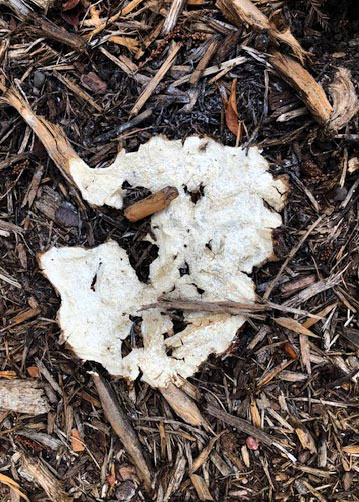
Answer: This is a saprophytic fungus that’s living off the decaying organic matter, either from the mulch or from the soil below. The cloud of dust is actually spores that are being released. It causes no harm to your plants or to pets or humans. You could apply dusting sulfur if you wanted to get rid of it, or it will go away in hot, dry conditions. You could also just stir it around with a hoe or rake to break it up. No big deal.
QUESTION 3
DIFFERENCES BETWEEN HARDY AND TROPICAL HIBISCUS.
Question: I am confused by the differences between tropical and hardy hibiscus. I have both. Please elaborate on each. Ed P., Farmers Branch.
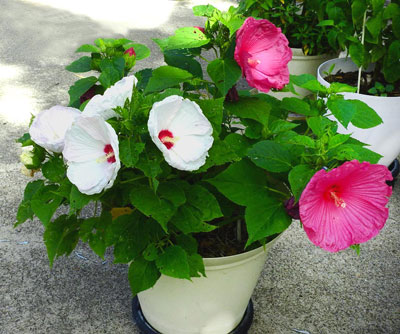
Answer: I could write a lot, but let me boil it down to the specifics:
• They both need full sun, or at the most, a couple hours of afternoon shade.
• Both use a great deal of water so plan on watering them frequently/daily during the hottest parts of the summer.
• Both bloom best if given high-nitrogen fertilizers. Tropical hibiscus bloom non-stop mid-spring until frost. Hardy hibiscus (as you have in your photo) bloom for 4-6 weeks in mid-summer.
• Tropical types have glossy foliage. Hardy types have more of a “matte finish.”
• Hardy types are generally single-flowering (one row of petals) in shades of red, pink and white. Confederate rose hibiscus are a double-flowering hardy type. Tropicals can be single- or double-flowering, with flowers in shades of red, pink, orange, yellow, white and others.
• Tropical types will freeze at 32F. Hardy types will survive winters clear into Canada. Although they will die to the ground, they will sprout back the following spring.
QUESTION 4
HOW AND WHEN TO SEPARATE PALMS
Question: When and how should I separate a dead windmill palm (killed by cold in February 2021) from its conjoined twin? Kim P., Bedford.
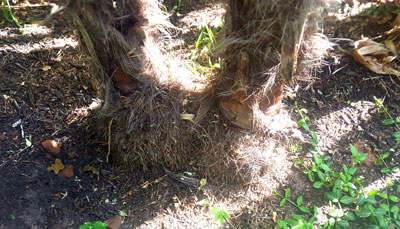
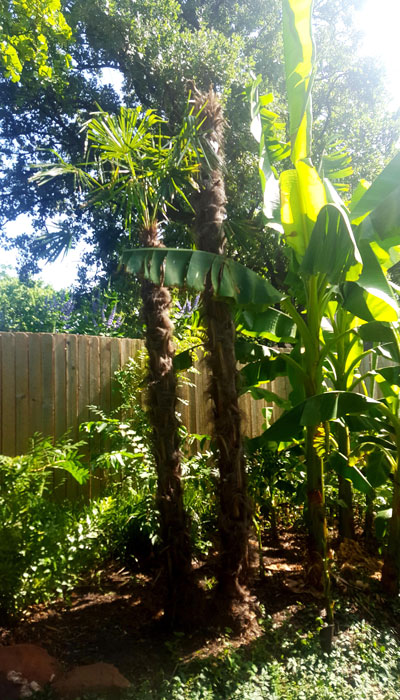
Answer: You can do that now. It looks like they are growing on two separate root systems. I would use a sharpshooter spade and slice through the dead trunk at the ground line. Don’t make it too complicated.
QUESTION 5
BEST SMALL, WHITE CRAPE MYRTLE
Question: What is the best small, white crape myrtle? JoeAnn S., Plano.
Answer: By “small,” I assume you mean dwarf. My choice in dwarf crape myrtles has always been the Petite series, and for white, that would be Petite Snow. It grows to be 4 to 5 ft. tall and wide and is nice and full. If you’re looking for something taller, check out the list in my story in this issue.
QUESTION 6
MAGNOLIA HAS LOST MANY LEAVES.
Question: My magnolia tree has dropped lots of leaves recently, and its trunk has looked diseased. What can be done to help it thrive?
Answer: Apply water and fertilizer. That’s all any tree needs to put on new leaves and grow. Magnolias typically drop last year’s leaves in late spring. They’ve just finished that for this year, so it’s time to feed and water them. As for the trunks, you may be looking at lichens. They’re harmless colonies of algae and fungi that nourish one another. No call to action.
QUESTION 7
WILL THESE PLANTS SURVIVE FULL SUN?
Question: Recent removal of a huge dying oak completely crushed the Turk’s cap, Mexican firespike, plumbago and a 15-year-old Texas mountain laurel that were living happily beneath it. Will they grow back, and can they handle full sun? Carol D., Brenham.
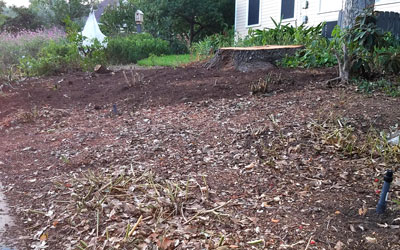
Answer: Oh, my. That looks like Ground Zero. They should be fine with the sun, but I can’t tell you if they will come back. It’s a shame they had to have all of their top growth removed. All I can recommend to you is that you apply a high-nitrogen lawn fertilizer (no weedkiller included, of course) and water deeply. Sit back and see what happens.
QUESTION 8
WHY DID OAKLEAF HYDRANGEA NOT BLOOM?
Question: Our oakleaf hydrangea did not bloom this year. It has for the two previous years. Do you have any suggestions? Mary Catherine C., Collin Co.

Answer: It certainly looks vigorous, but if I had to guess I would suspect that it has been pruned at some point in the past 6-7 months. It’s so short and compact. Of course, there are dwarf varieties, but this plant’s leaves are quite large, and you didn’t mention a dwarf variety name. I have 12-15 oakleaf hydrangeas and mine didn’t bloom as well as usual. It may have been the weather in late winter and the cold early spring. As healthy as your plant looks I’m sure it will pick up the pace in the future. Remember not to prune it except right after it blooms.
QUESTION 9
GRASSHOPPER CONTROL.
Question: How can I control grasshoppers? Cecelia N., Falls Co.
Answer: If you will Google “university Extension grasshopper control” you will find dozens of matches from the nation’s ag colleges. Most of those address the insects’ impact on farm crops. I believe this one addresses them very well from a home gardening standpoint.
My short-form suggestions are…
• Eliminate all tall weeds that could harbor grasshopper populations.
• Address grasshoppers as soon as you see the first signs of an infestation.
• Use a legally labeled insecticide for their control.
• Spray from the tops of the plants down so the spray pattern will cover the grasshoppers as they attempt to escape.
• Repeat treatments as necessary.
QUESTION 10
WHY FEW BLOOMS ON SCENTSATIONAL HONEYSUCKLE?
Question: My two-year-old Scentsational honeysuckle has seldom bloomed and the leaves are always blackened and curled around the edges. What ails it? Michael D., Fort Worth.
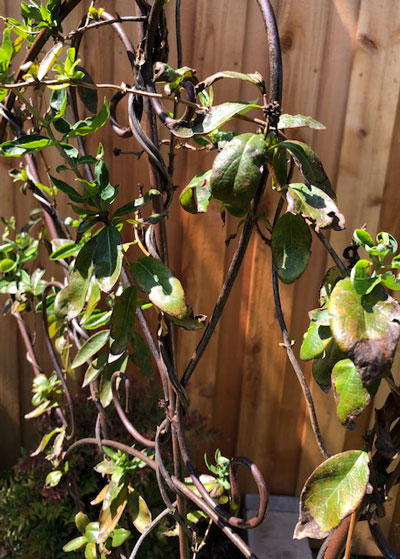
Answer: Some types of honeysuckles aren’t as well adapted to Texas as we might want them to be. I haven’t grown this one, but your photo certainly looks like many of the others. My guess on the browned leaves is that they have been hit with powdery mildew. Having read the online reviews I’d estimate that this plant may never live up to your hopes and expectations. Mercifully, I might suggest that you move on to some other species.
QUESTION 11
LACEBARK ELMS SHOWING SIGNS OF STRESS.
Question: Recently one of our lacebark elms began showing signs of stress. One of the top branches turned brown. An arborist recommended deep root fertilization at a high price. Do you feel a topical fertilizer would be enough?
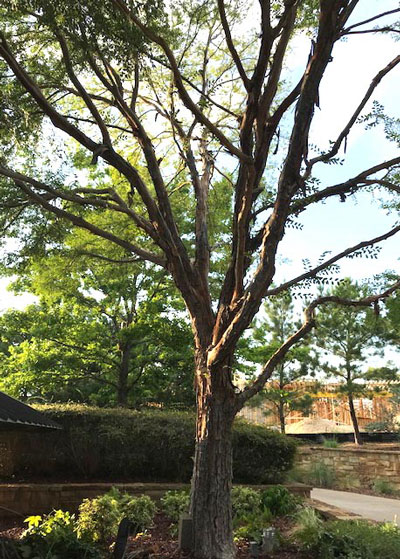
Answer: It looks like a lovely tree. I wish I could see it better to get a more accurate idea of the symptoms. Cotton root rot, a soil-borne fungus, is the one disease that commonly attacks lacebark elms. It kills the entire tree simultaneously, so I guess that’s probably not your tree’s issue. Beyond that, I can only suggest you contact a certified arborist to look at the tree on site. As for the deep-root feeding, my answer would depend on the cause of the problem. If 90 percent of any tree’s roots are in the top foot of soil, it would seem to me that surface application of fertilizer followed by a deep watering should be adequate.
QUESTION 12
WILL APPLYING PRE-EMERGENT GRANULES AFFECT NEW SOD?
Question: I had some patches of my St. Augustine affected by TARR. If I apply pre-emergent weedkiller will it affect the runners’ ability to root in those areas? Should I spot treat only the healthy areas? Andrea S., Lewisville.
Answer: There isn’t much reason to apply pre-emergent granules at this late date. You’re past the deadline. The timing in Lewisville would be early March, repeating in early June. Plant your new sod and deal with weeds next year.
QUESTION 13
WHAT KILLS LAMBS EAR?
Question: I have lots of lamb’s ear, but every year I lose areas of it. They die in late June or July. What might cause this? Rebekah C., Denton Co.
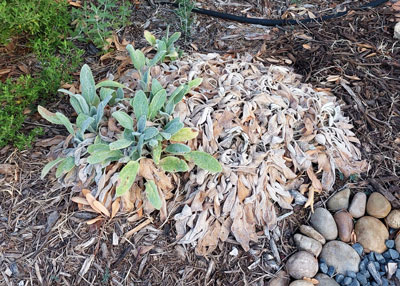
Answer: When I see this it’s tied to heavy soils in hot, sunny locations and it follows periods of high humidity and rainy weather. That said, it looks like you have yours growing around other water-conscious plants. However, if these are in clay soils, I suspect that’s your issue. See if the worst of the die-out is in the heaviest clay. Working the soil to loosen it prior to planting is probably a better expenditure than applying fungicides.
QUESTION 14
ARE THESE GROWTHS OF CONCERN ON CEDAR ELM?
Question: One of my cedar elm trees has 15 or 20 leaves covered in these small green pods. They’re about ½-inch long. I’m assuming they’re caused by an insect. Do I need to be concerned? Do I need to treat them? Tori S., Rhome, Wise Co.
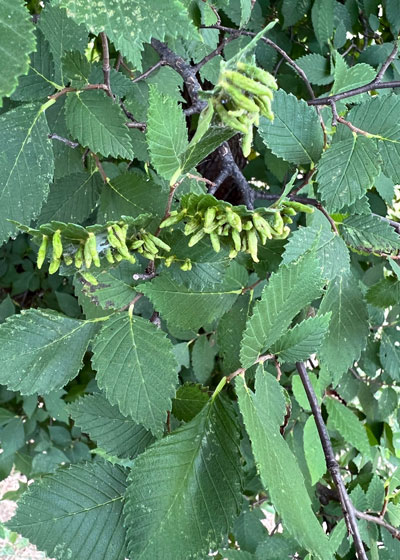
Answer: These are insect galls. I believe if you Google “elm sack-gall aphid Tetraneura ulmi” you will find examples to confirm. The adult female insect lays her eggs in the leaf surface. The gall forms from leaf tissues and acts to protect the larvae as they develop. There is no effective preventive measure, nor is there any control. No call to action.
QUESTION 15
WHAT HAPPENED TO MY JAPANESE ARALIA?
Question: I planted a Japanese aralia this spring. It was doing great, but this past week I noticed that the leaves were starting to droop and then turn black. Now it looks dead. I was watering this bed every day. Did I overwater it? Nancy T., Taylor.
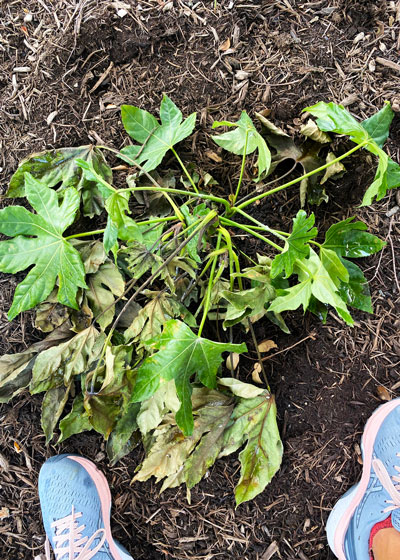
Answer: I can’t tell how much water you were applying each time that you watered. This plant looks like it got too dry at least one time. Or perhaps like it was exposed to too much sunlight in this really hot, sunny weather. This species must have shade in Texas – certainly no sun after mid-morning. This was not caused by insects or diseases. I guess you might have overwatered it, but that’s rarely the case in mid-summer. For every 1,000 people who think they have over-watered a plant, probably only one actually has.
QUESTION 16
IS THIS GRAY LEAF SPOT, THATCH OR SOMETHING ELSE IN ZOYSIA?
Question: This is Zorro zoysia. Is this gray leaf spot, thatch or something else? This is the first year it hasn’t greened up. Mark S., Mansfield.
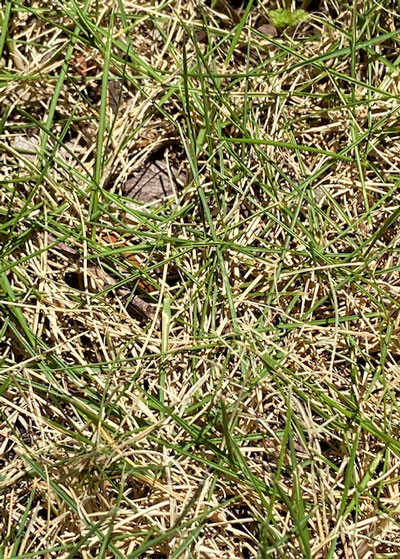
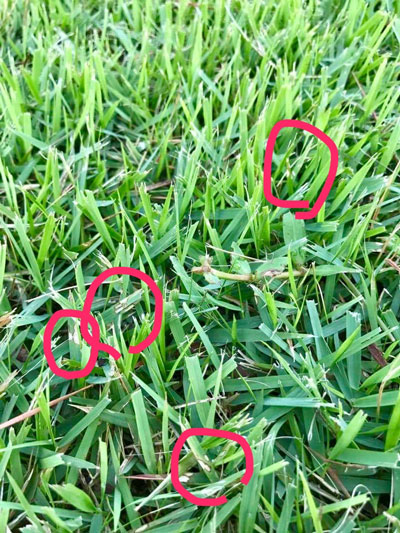
Answer: I can’t zoom in enough on the blades to see for sure if there are gray/brown, diamond-shaped lesions. I kinda think there might be. That’s what would identify gray leaf spot, and Azoxystrobin would be your control. I’ll have to leave that confirmation up to you. I have included a photo posted to my Facebook page 5 years ago showing gray leaf spot on JaMur zoysia. Perhaps it will help as you look at your grass closely.
Thatch would be a compressed layer of organic matter that would be impenetrable for water and nutrients. It doesn’t look like thatch to me, but again, I can’t see it up close. If you find thatch, you could use an aerator to pull plugs out of the lawn without doing significant harm to the lawn. You do not want to use a dethatcher.
